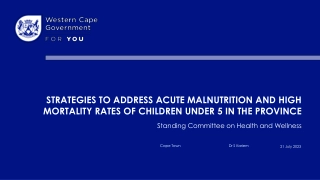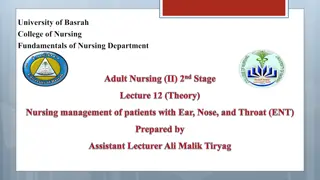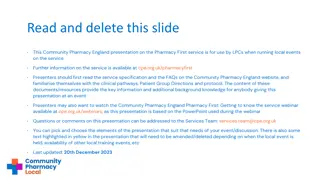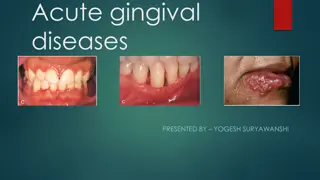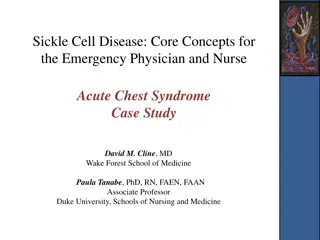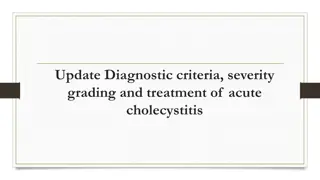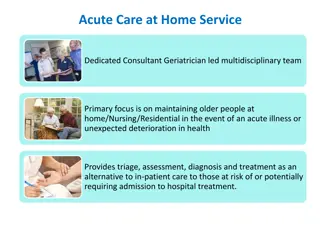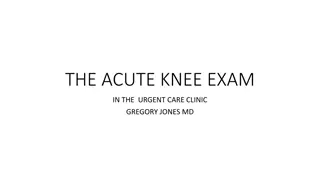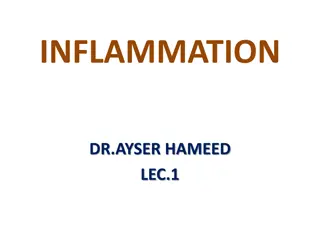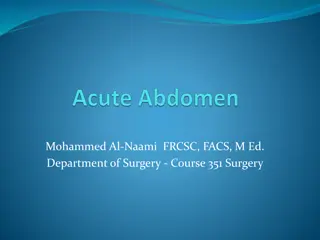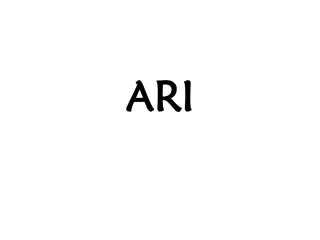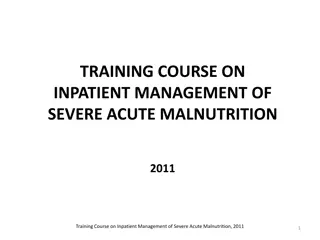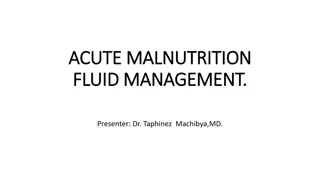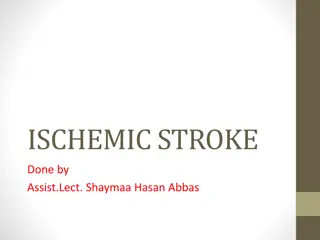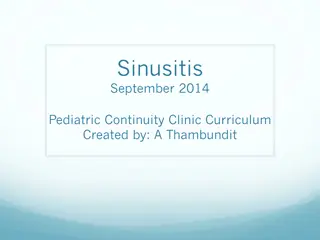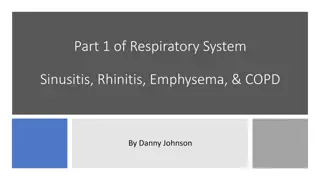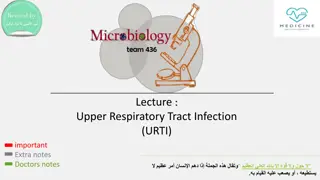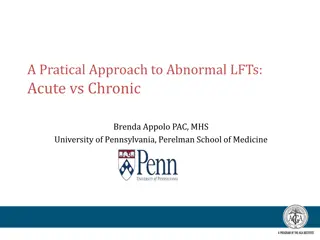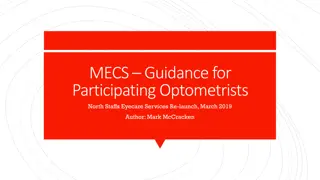Acute sinusitis
Dr. Ali Abed Mohammed specializes in diagnosing and treating acute sinusitis. Learn more about the causes, symptoms, and treatment options for this common condition. Find expert advice and guidance on managing acute sinusitis effectively to improve your quality of life. Stay informed and take proactive steps towards relieving sinusitis symptoms with the help of Dr. Ali Abed Mohammed.
Download Presentation

Please find below an Image/Link to download the presentation.
The content on the website is provided AS IS for your information and personal use only. It may not be sold, licensed, or shared on other websites without obtaining consent from the author.If you encounter any issues during the download, it is possible that the publisher has removed the file from their server.
You are allowed to download the files provided on this website for personal or commercial use, subject to the condition that they are used lawfully. All files are the property of their respective owners.
The content on the website is provided AS IS for your information and personal use only. It may not be sold, licensed, or shared on other websites without obtaining consent from the author.
E N D
Presentation Transcript
* Acute sinusitis DR. Ali Abed Mohammed
Definition: Acute inflammation of the mucoperiosteum lining the nasal sinuses. Aetiology: viral ,bacterial ,fungal intranasal allergies, such as hay fever nasal polyps or other tumors deviated nasal septum infected adenoids cystic fibrosis, an inherited genetic disease where thick, sticky mucus builds up in the body Causative organisms: Streptococcus Pneumonia, Haemophilus influenza and moraxella catarrhalis. Anaerobes in maxillary sinusitis of dental origin.
Source of infection: I. Nasal: a. Acute rhinitis is the commonest. b. Nasal packing for long time. c. Nasal foreign body. 2. Dental: Unilateral maxillary sinusitis mostly is an anerobic infection through: 1. Dental infection: of upper second premolar or first molar tooth. 2. Oro-antral fistula: after extraction of the upper second premolar or first molar teeth. 3. Traumatic: Fracture of the sinus, sinus foreign body, sinus barotraumas. Pathology: Acute catarrhal followed by suppurative sinusitis: There is congestion and oedema of the sinus mucosa with inflammatory exudates. Oedema leads to occlusion of the ostium, retention of exudates inside the sinuses,then may pus formation by suppurative microorganisms.
Clinical features Symptoms: Nasal obstruction, nasal discharge which is mucopurulent as in maxillary sinusitis due to dental origin, and postnasal mucopurulent discharge (post- nasal drip). Fever, facial pain and headache, pain is usually over the affected sinus as following: Maxillary sinusitis: the pain is over the cheek and referred to ears and teeth, in frontal sinusitis: it over the forehead and headache it starts in the morning increased on bending, and subsides at noon, in ethmoidal sinusitis it s found in-between eyes, while in sphenoidal sinusitis the pain is retro-orbital and occipital Earache ,toothache bad breath, reduced sense of smell, reduced sense of taste. Signs: 1- Swelling and redness of the skin tenderness elicited over the affected sinus: as over the cheek in maxillary sinusitis, on the floor of the frontal sinus in frontal sinusitis, while in ethmoidal sinusitis it is found medial to the inner canthus (the area between the eye and the nose).
2- Nasal cavity examination: a) Generalized swelling and hyperaemia of the nasal mucosa over the turbinates. b) Mucopurulent discharge: in middle meatus as seen in maxillary, frontal, anterior and middle ethmoidal sinusitis, and it seen in superior meatus, as in posterior ethmoidal sinusitis, while if it seen in sphenoethmoidal recess this is due to sphenoidal sinusitis. 3. Postnasal mucopurulent discharge as it detected by posterior rhinoscopy. Investigations: 1. Culture and sensitivity test of the nasal discharge. 2. X-ray for sinuses: fluid level, thickened mucosa, or Total opacity of the affected sinus.
treaetment Medical: To control the infection, to decrease oedema around the ostium and help sinus drainage and ventilation. 1-Antibiotics: As Amoxicillin 500 mg three time daily for 10 days, and if allergic to penicillin, in this condition we can use Co-trimoxazole two tablet twice daily, or Erythromycin. 2- Analgesics and antipyretics: as paracetamol. 3- Systemic decongestants and antihistamines preparation: as Pseudoepiphdrine. 4- Decongestive nasal drops: as Oxymetazoline or Xylometazoline nasal drop. Surgical: Indications: to drain infected sinus in case of: 1. Failed adequate medical treatment. 2. Threatened complications of sinusitis. To remove the pus, restore the ciliary activity, and to ventilate the sinus, as : Antral washout which may be used in maxillary sinusitis, also trephine the floor of frontal sinus in case of frontal sinusitis, while in other types of sinusitis, the lavage is impractical
COMPLICATIONS 1- Cellulitis of the subcutaneous tissue of the face. 2- Mucocoele: frontal sinus mucocole in adult and ethmoidal sinus mucocoele in children. Mucoceles are cystic masses that generally affect the sinuses. It occurs as a result from obstruction of the ostium of a sinus and consequential accumulation of mucus. Frontal and ethmoid sinuses are mostly affected. Usually, the clinical symptoms are insidious, varying with the extent of the affected region.(extra) 3- Dental complication: as oro- antral fistula. 4- Orbital Complications: as a. Eyelid cellulitis (preseptal cellulitis). b. Orbital cellulitis (postseptal cellulitis). c. Subperiosteal abscess. d. Orbital abscess. 5- Osteomyelitis; In adult osteomylitis of frontal bone (puffy potts tumor), and in children osteomyelitis of maxilla. 6- Pulmonary complications, 7- Intracranial Complications: Meningitis, extradural abscess, subdural abscess, brain abscess, and cavernous sinus thrombosis. 8- Chronic sinusitis. .


